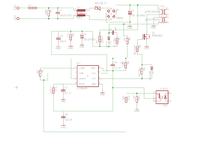I put all the parts in the starting resistor, I gave 270 Ohm and the resistor from the 32 Ohm transistor, but the charger does not work.
How to check if the inverter has taken the trick?
The supply voltage of the converter is about 14-15V.
I don't know why there is no voltage on the auxiliary winding of the transformer.
I made a piece of the schematic:

I replaced the diode and capacitor, but there is still no voltage.
How to check if the inverter has taken the trick?
The supply voltage of the converter is about 14-15V.
I don't know why there is no voltage on the auxiliary winding of the transformer.
I made a piece of the schematic:

I replaced the diode and capacitor, but there is still no voltage.




